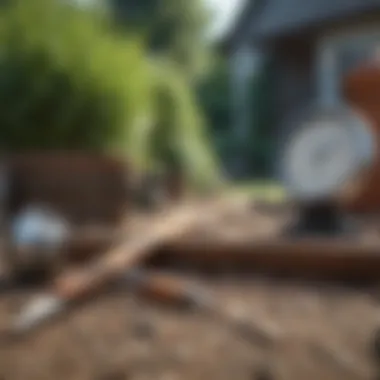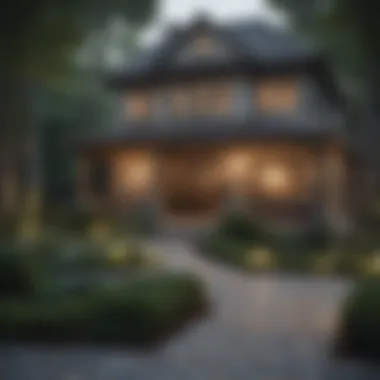Calculating Yard Square Footage: A Comprehensive Guide


Intro
Understanding the square footage of yards is vital. Whether you engage in landscaping, construction, or real estate, accurate measurements are essential. This guide aims to break down the methods of calculating yard square footage.
Knowing how much space you have can greatly affect your projects and investments. For homeowners, it helps in planning gardens, patios, or lawns, while real estate professionals require it for property listings.
This article will explore techniques and tools used in calculating yard areas. We will also examine best practices and tips to ensure that your measurements are precise.
By the end, you should have a clear understanding of how to measure and calculate yard square footage effectively.
Prolusion to Yard Square Footage
Understanding yard square footage is a foundational skill for anyone involved in landscaping, construction, and real estate. The ability to accurately measure outdoor spaces has numerous implications, from optimizing garden layouts to assessing property values. When square footage calculations are precise, projects are more likely to stay on budget and meet design expectations.
Defining Square Footage
Square footage refers to the area of a two-dimensional space measured in square units. In the context of yards, this specifically pertains to the size of open land or garden areas. Each unit of square footage represents a square that is one foot long on each side. For example, a yard that measures 10 feet by 10 feet would have an area of 100 square feet. This clarity in definition is crucial when planning any kind of project where space utilization is important.
Importance of Accurate Measurements
Accurate measurements stand as the bedrock of effective yard planning. When measurements are not precise, it can lead to a cascade of issues, including:
- Overestimation of Land Needs: This could result in unnecessary expenses for materials or labor.
- Undersized Designs: Creating an outdoor layout that does not fit the available space.
- Compliance Issues: Many local regulations require exact measurements for landscaping projects.
"Precision in yard measurements is not just a technical necessity; it shapes the entire project outcome."
In summary, understanding the significance of yard square footage and the implications of measurement accuracy is vital. Whether you are enhancing your property's aesthetics or evaluating its real estate potential, the calculations derived from accurate measurements will guide every decision.
Tools Required for Measuring
Accurate square footage calculation relies heavily on the tools employed for measuring. Without the right instruments, even the best techniques become less effective. It is essential to prioritize the use of reliable measuring tools to ensure precision in calculations. The selection of appropriate tools is influenced by factors such as the size of the area, the complexity of the layout, and the user's level of expertise. Here are three key tools commonly used for measuring yard square footage:
Tape Measure
The tape measure is a fundamental tool for measuring distance. It offers simplicity and versatility, ideal for both small and medium-sized areas. Most tape measures are flexible, allowing the user to easily navigate around corners and various obstacles.
Benefits of Using a Tape Measure:
- Portability: Tape measures are lightweight and easy to carry.
- Ease of Use: They don’t require any special training; even a novice can operate them efficiently.
- Cost-Effectiveness: Available at affordable prices, making them accessible to everyone.
When using a tape measure, ensure it is fully extended and held straight to avoid inaccurate readings. It is also wise to have a partner assist when measuring larger areas to provide more accurate results.
Measuring Wheel
A measuring wheel is particularly beneficial for larger properties. It consists of a wheel connected to a measuring handle, enabling the user to roll it along the ground. This tool is particularly efficient for measuring linear distances.
Considerations When Using a Measuring Wheel:
- Surface Type: It works best on flat surfaces. Irregular terrain may affect accuracy.
- Calibration: Regularly calibrate the wheel to confirm its accuracy over time.
- Physical Ability: It may require more effort and strength to handle than a tape measure, especially on uneven ground.
Using a measuring wheel can significantly speed up the process of measuring large areas. However, users should remain aware of the potential for error due to slope or terrain variations.
Digital Measuring Tools


Digital measuring tools offer a modern and efficient approach to yard measurements. These tools include laser distance meters and smartphone applications designed for accurate calculating.
Advantages of Digital Measuring Tools:
- Precision: Offers increased accuracy compared to traditional tools.
- Ease of Use: Most devices provide instant readings with minimal effort.
- Data Collection: Some devices allow for the storage of measurements and calculations for future reference.
Digital measuring tools may incur a higher initial investment but can save time and offer improved accuracy for complex measurements. For users keen on technology, these tools represent a significant advancement in measuring techniques.
Key Insight: Selecting the right measuring tool is fundamental for achieving accurate yard square footage calculations. Each tool has its advantages and drawbacks, depending on user needs and measurement requirements.
Basic Calculation Techniques
Understanding and applying basic calculation techniques is fundamental when it comes to determining yard square footage. These techniques serve not only to provide accurate measurements but also to enhance the effectiveness of various landscaping and construction projects. For homeowners and design enthusiasts, mastering these techniques can lead to better planning, budgeting, and execution of outdoor spaces, ensuring that every square foot is utilized efficiently.
Rectangular Areas
Calculating the area of rectangular spaces is one of the simplest and most straightforward techniques. This is primarily because all you need are the lengths of two sides. The formula for square footage is:
Area = Length × Width
To ensure accuracy, measuring should be done in feet. For instance, if a yard measures 20 feet in length and 15 feet in width, the calculation would look like this:
- Area = 20 ft × 15 ft = 300 square feet.
Using a tape measure is ideal for these measurements, and it’s advisable to recheck the lengths for consistency. Precise measurements will contribute to creating a well-defined space.
Circular Areas
When dealing with circular spaces, the calculation becomes slightly more complex. The area of a circle is defined by the formula:
Area = π × Radius²
Here, π (Pi) is approximately equal to 3.14. To illustrate, if the radius of a circular garden is 10 feet, the calculation will be:
- Area = 3.14 × (10 ft)² = 314 square feet.
It is essential to measure from the center of the circle to the outer edge for an accurate radius. A measuring wheel can often simplify this process, especially for larger gardens where using a standard tape measure might be unwieldy.
Irregular Shapes
For irregularly shaped areas, calculations can be challenging, but they are manageable with the right approach. One effective method is to divide the irregular shape into recognizable geometric figures, such as rectangles, triangles, or circles, to simplify the calculation process.
- Divide the Area: Break the shape down into smaller, quantifiable sections.
- Calculate Individual Areas: Use the appropriate formulas for each section (rectangular, circular, triangular).
- Sum the Areas: Add up the calculated areas to find the total square footage.
This method allows for a more accurate and detailed assessment, providing a clearer picture of the yard's dimensions. Utilizing a grid method can also aid in mapping out the area for more complicated designs, ensuring all features are accounted for in the final calculations.
Step-by-Step Measurement Process
The step-by-step measurement process is crucial for obtaining accurate yard square footage. This systematic approach ensures that one does not miss any critical details, leading to precise measurements. Each step builds on the previous one, making the entire task easier and more reliable. When executed properly, a systematic measurement contributes significantly to the overall success of landscaping projects, construction plans, or property assessments. Mistakes can result in financial implications or delays, thus highlighting the need for thoroughness in this process.
Preparing the Area
Preparing the area is the first step in the measurement process. This phase involves clearing any obstacles that might hinder accurate measurements. Remove any furniture, debris, or plants that obstruct the path of your measuring equipment. Ensuring a clean area allows for unobstructed access to the zones you want to measure. This preparation not only simplifies the measuring task but also assures that the measurements taken reflect only the intended space, free from distractions or inaccuracies caused by surrounding items.


It's also beneficial to evaluate the terrain. Uneven ground can affect measurements if not considered. Use a level surface for the most precise results. Take note of any slopes or dips that may impact the total area calculation, and be prepared to account for these variations later in your calculations.
Marking Boundaries
Once the area is prepared, the next step is marking boundaries. Clearly defining the limits of the area to be measured is essential for accuracy. Use stakes and string or chalk lines to outline the perimeter. This visual representation prevents confusion during the measuring process. It also helps in getting a clear picture of your yard’s layout.
When marking boundaries, it is critical to ensure that they reflect the true shape of the area. Measure distances between markers accurately. If the property has curves or unique features, ensure these are encompassed in your markings. Having well-defined boundaries also aids in future assessments or landscaping decisions.
Take extra care to ensure that the boundaries are straight and precisely measured. Any mistakes here will multiply as you calculate the total square footage.
Taking Measurements
Taking measurements is the final step, which involves the actual gathering of data. Use the tools selected in the previous sections like a tape measure or digital measuring tool to measure each side of the marked boundaries. Record these measurements carefully. Depending on the shape of the area, apply the appropriate formula to calculate the square footage. For rectangles, multiply the length by the width. For circular areas, use the formula for calculating the area of a circle. Ensure you are working systematically to avoid missed measurements or miscalculations during this process.
If measuring irregular shapes, consider dividing the area into smaller, manageable sections to simplify calculations. After measurements are taken, double-check numbers to confirm your findings.
In summary, the step-by-step measurement process lays the groundwork for accurate yard square footage calculations. Each step, from preparation to taking measurements, is vital to achieving precision and consistency. Approach the task methodically to avoid common pitfalls, ensuring your measurements align with your project goals.
Advanced Techniques for Complex Properties
In the realm of yard square footage calculations, basic methodologies suffice for straightforward layouts. However, more complex properties often present unique challenges. Thus, advanced techniques are crucial for ensuring precision, especially in scenarios where irregularity in shape occurs. Understanding these methods can aid property owners or landscaping specialists in accurately assessing their space. This ensures they maximize their design potential without incurring additional costs due to miscalculations.
Using Grids
One effective advanced technique involves employing a grid system. Utilizing a grid allows for a more systematic approach to measuring complex yard shapes. To employ this method, follow these steps:
- Lay out a grid: You can use stakes and string to create a defined grid over the property area.
- Divide and conquer: Each square can be measured individually, simplifying the calculation process.
- Sum the areas: After measuring, add up all the individual square footage pieces to arrive at the total.
This technique is particularly beneficial for intricate landscapes, as it divides a challenging area into manageable parts. By focusing on smaller sections, it becomes easier to achieve greater accuracy. Furthermore, scientists and designers often recommend this method when dealing with multi-level terrains or properties with various garden features.
Calculation Software
Advancing into the digital age, calculation software has emerged as a powerful tool for yard square footage determination. This software can streamline the measuring process for complex properties and offer quick solutions despite intricate geometry. Here are some notable advantages of using calculation software:
- Automated calculations: Users input measurements, and the software computes the area instantly.
- Visual aids: Many programs provide visual representations of layouts, allowing for enhanced understanding of spatial relationships.
- Design integration: Certain software, such as SketchUp or AutoCAD, gives homeowners the ability to plan and visualize their landscaping projects in real-time.
By incorporating software techniques, users can significantly reduce human error, saving time and providing flexibility in planning. Many software programs also have support communities or resources available online, making their integration into regular practices quite accessible.
The combination of grid systems and calculation software ensures a comprehensive approach to complex property measurements. Adapting these advanced techniques can lead to more accurate results and, ultimately, a better realization of design aspirations.
Applications of Yard Square Footage Calculations
Understanding yard square footage has practical implications across various domains. Accurate measurements can streamline processes, enhance decisions, and ultimately lead to effective outcomes.
Landscaping Projects
When embarking on landscaping endeavors, precise measurements are essential. Knowing the square footage of a yard helps in planning the placement of plants, structures, and features. It also allows homeowners to create a balanced aesthetic. For instance, when installing a patio or garden, knowing how much space is available will help in selecting appropriate materials and layouts.
Using square footage in landscaping helps in:
- Calculating plant quantities: Accurate measurements ensure the right number of plants are purchased.
- Budgeting for materials: Knowing the area helps in estimating costs for grass, gravel, or pavers.
- Avoiding overcrowding: It aids in designing a yard that is visually appealing and functional.
Construction Planning


In the construction industry, square footage calculations play a critical role. These measurements are foundational for architectural designs and project estimates. Before laying a single brick or putting up a wall, contractors rely on accurate square footage to deliver effective planning. It affects everything from material supply to labor costs.
Considerations include:
- Architectural blueprints: Projects begin with a design that defines square footage, impacting the structure's overall aesthetic and utility.
- Cost analysis: Builders can estimate material needs and costs based on the square footage computed.
- Permitting: Many local regulations require area specifications, making accurate measurements crucial for compliance.
Real Estate Considerations
In real estate, yard square footage serves as a fundamental metric in property valuation. It provides insight into the potential for landscaping or expansion. Buyers assess square footage along with other features when evaluating a home, which can impact resale value.
Key points that real estate agents and buyers often consider include:
- Market comparisons: It helps in comparing similar properties in a neighborhood.
- Investment potential: Larger yards may offer opportunities for improvements or additions.
- Buyer appeal: Properties with well-measured outdoor spaces can attract more buyers, reflecting enhanced livability.
Common Mistakes to Avoid
Calculating yard square footage accurately is vital. However, many people fall into common traps that can lead to significant errors. Recognizing these mistakes can save time and ensure that your measurements are precise, enhancing the effectiveness of your landscaping or construction projects.
Overlooking Measurements
One prevalent mistake is overlooking measurements. This often occurs when individuals assume the dimensions of their yard or certain sections within it. It might seem harmless to estimate, but assumptions lead to inaccuracies.
Measuring each aspect of your yard, including corners and edges, is essential. Missing even a small area can result in an incorrect total square footage calculation. Inaccurate measurements can lead to overspending on materials or creating designs that do not fit well within the provided space. The following points illustrate the importance of thorough measurements:
- Precision: Accurate measurements ensure that your landscaping fits harmoniously within your yard.
- Material Budgeting: Knowing the exact area helps in budgeting for materials needed.
- Design Integrity: Poor measurements can alter the intended design.
Planning to take your measurements on a clear day is also helpful. Nurturing a habit of double-checking measurements can prevent potential errors.
Ignoring Landscape Features
Another mistake to be cautious of is ignoring landscape features. Everything from trees to slopes can influence the way we measure square footage. Certain elements often go unnoticed in calculations, leading to underestimation of the needed area.
Ignoring these features can cause problems in both landscaping and construction tasks. When you fail to account for these aspects, you may find:
- Inadequate Space for Features: Features such as a new garden or seating area may not fit properly if the main yard measurement does not consider existing elements.
- Unintended Design Flaws: If you ignore sloped areas or water drainage features, it can lead to complications with the overall design that can be costly and time-consuming to rectify.
- Maintenance Challenges: Ignoring landscape features might create areas that are difficult to maintain, leading to an unhygienic or unkempt appearance.
Taking the time to assess your yard's unique characteristics is crucial for effective square footage calculations.
"Ignoring what your yard has to offer can transform a well-planned project into a troubled endeavor."
By prioritizing comprehensive measurements and not overlooking any landscape features, you set the stage for successful design execution. This approach results in a clearer path to a finished, visually pleasing yard. Careful consideration saves you resources, enhances aesthetics, and allows for a well-planned use of space.
End
The conclusion of this comprehensive guide is vital in reinforcing the principles explored throughout the article. Understanding how to accurately calculate yard square footage is not merely an academic exercise; it serves a practical purpose in various domains. For homeowners, precise measurements are crucial in optimizing landscaping designs, ensuring that every plant and path fits harmoniously within the space. For professionals in construction and real estate, these calculations validate project scopes and appraisals, solidifying the value of properties.
Summary of Key Points
In summary, several key points from this guide stand out:
- Definition of Square Footage: Knowing what square footage means and why it matters helps clarify the significance of the measurements.
- Tools Required: A range of tools, such as tape measures and digital measuring devices, can enhance measurement accuracy.
- Basic Techniques: Techniques for calculating rectangular, circular, and irregular areas are essential for effective yard measurement.
- Advanced Techniques: Employing grids and software can simplify the calculation process for complex properties.
- Applications: Understanding yard measurements has implications in landscaping projects, construction planning, and real estate evaluations.
- Common Mistakes: Awareness of common errors can help avoid inaccuracies in yard measurements.
"Accurate yard measurement is fundamental to effective landscaping and construction, ultimately leading to more successful projects."
Final Thoughts on Precision in Measurements
Precision is paramount in measuring yard square footage. Accurate calculations enable informed decision-making, leading to better outcomes in design and property management. When measurements are accurate, the potential for aesthetically pleasing landscapes and structurally sound constructions increases.
For those who wish to emphasize quality in their work, prioritizing precision in measurement processes will yield significant dividends. Whether you are a homeowner enhancing your outdoor space or a professional in the real estate sector, remember that every square foot counts in creating functional and appealing environments.







